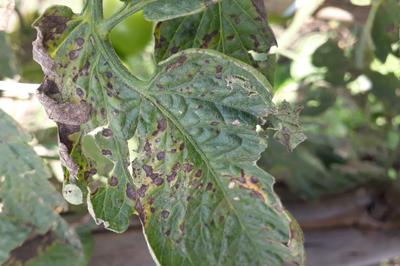Septoria Leaf Spot
Septoria lycopersici
Fungus
In a Nutshell
- Small gray circular spots with dark-brown margins on undersides of older leaves.
- Black dots in their centers.
- Leaves turn slightly yellow, wither, and fall off.
- Stems and blossoms can also be affected.
Can also be found in
Symptoms
Symptoms spread upwards from oldest to youngest growth. Small, water-soaked grey circular spots with dark-brown margins appear on the undersides of older leaves. At later stages of the disease, the spots enlarge and coalesce, and black dots appear in their centers. The same pattern may also be observed on stems and blossoms, but rarely on fruit. Heavily infected leaves will turn slightly yellow, wither, and fall off. The defoliation leads to sun scalding of fruit.
Recommendations

Organic Control
Copper-based fungicides, such as Bordeaux mixture, copper hydroxide, copper sulfate, or copper oxychloride sulfate might help control the pathogen. Apply at 7 to 10 day intervals throughout the late season. Follow harvest restrictions listed on the pesticide label.

Chemical Control
Always consider an integrated approach with preventive measures together with biological treatments if available. Fungicides containing maneb, mancozeb, chlorothalonil effectively control Septoria leaf spot. Apply at 7 to 10 day intervals throughout the season, mainly during flowering and fruit setting. Follow harvest restrictions listed on the pesticide label.
What caused it?
Septoria leaf spot occurs worldwide and is caused by the fungus Septoria lycopersici. The fungus infects only plants of the family of potato and tomato. The temperature range for the development of the fungus varies between 15° and 27°C, with optimal growth at 25°C. Spores might be spread by overhead water, splashing rain, hands and clothing of pickers, insects such as beetles, and cultivation equipment. It overwinters on solanaceous weeds and for short periods in soils or soil debris.
Preventive Measures
- Acquire certified disease-free seeds.
- If available, use resistant varieties.
- Apply organic or plastic mulch to avoid transmission from soil.
- Remove infected leaves and destroy them.
- Improve air circulation and keep plants off the ground with stakes.
- Make sure that production areas are free of susceptible weeds.
- Do not use sprinklers or other overhead irrigation.
- Keep your equipment and tools clean after field work.
- Dig plant debris deep in the soil after harvest.
- Alternatively, remove and destroy them.
- Plan a crop rotation for several years with non-susceptible plants.



